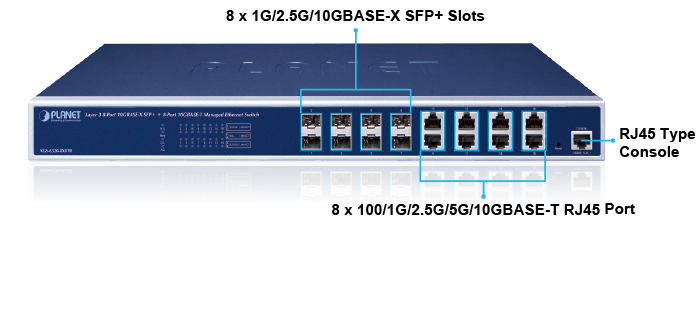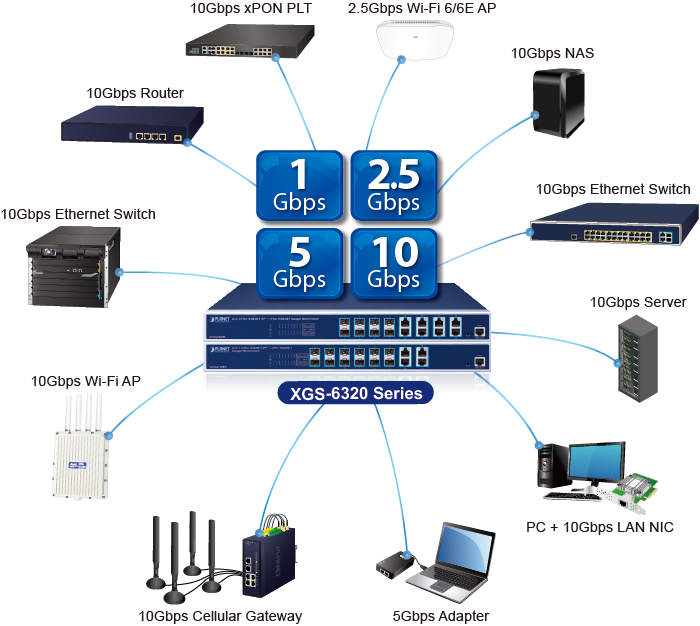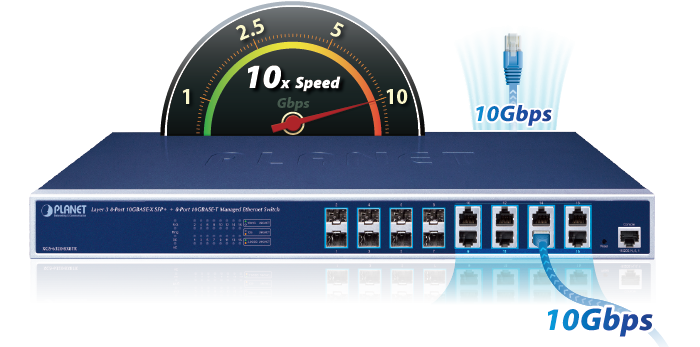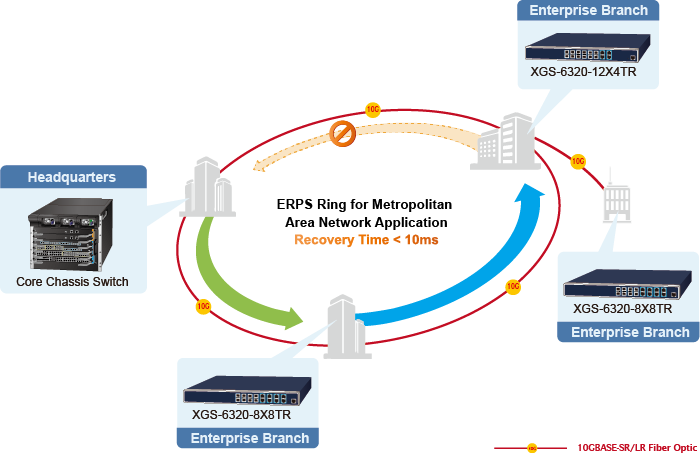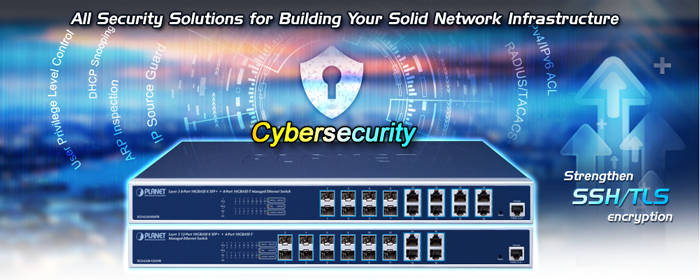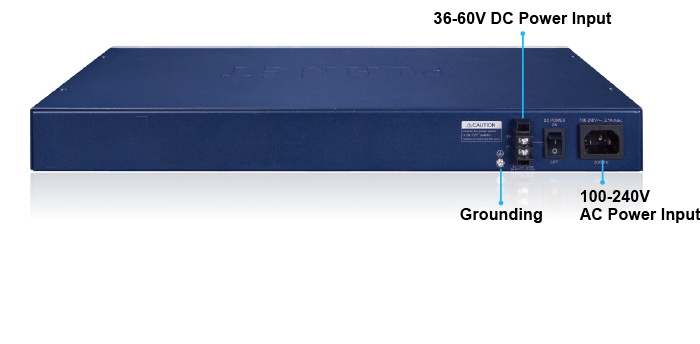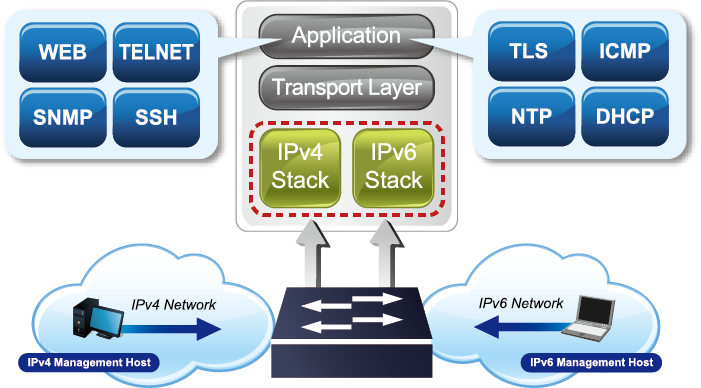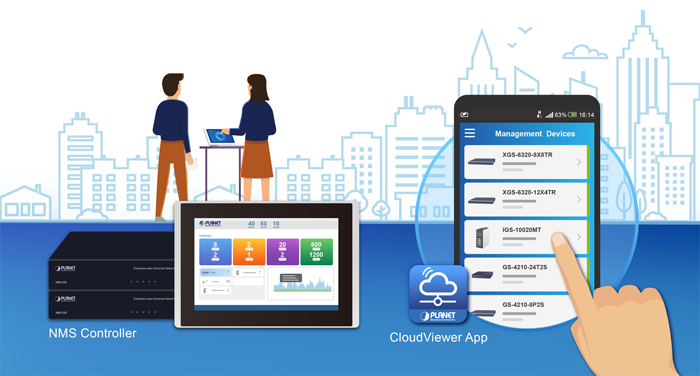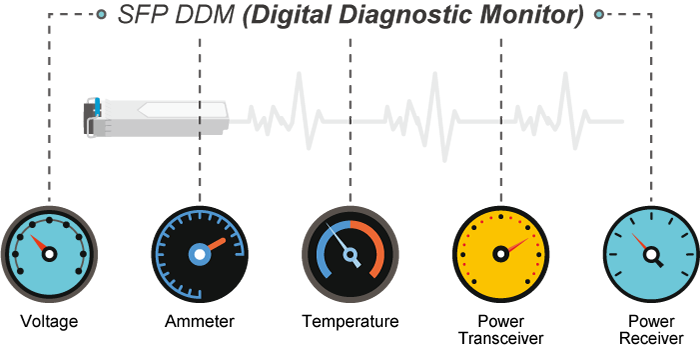Product added to cart
Planet Layer 3 8-Port SFP+ 8-Port 10GBASE-T Managed Ethernet Switch
MPN: XGS-6320-8X8TR
SKU: PLA-XGS-6320-8X8TR
UPC:
$1,636.00
Special Price : (Login for Your Price)
Availability
Usually Ships 10-14 Business Days
Perfect Managed All-port 10Gbps Switch with L3/L2 Switching and Security
PLANET XGS-6320-8X8TR is a fully-managed all-port 10Gbps Ethernet switch designed for the demand of high bandwidth for advanced network equipment, such as Wi-Fi 6/6E wireless AP, NAS, workstation and those with 10Gbps fiber or copper interfaces. It features 8 10GBASE-T copper ports and 8 10GBASE-X SFP+ fiber ports that are flexibly designed to extend the connection distance.
With such a favorable data link capability, hardware-based Layer 3 routing performance, Layer 2 and Layer 4 switching engine and user-friendly yet advanced IPv6/IPv4 management interfaces, it helps to accelerate the deployment of the next-generation high-bandwidth required network for metro, smart cites and enterprises.
10GBASE-T and 10GBASE-X SFP Dual Media Interfaces for Diversified Bandwidth Applications
PLANET XGS-6320 series has the capability to reach a high speed of 10Gbps over copper or fiber-optic cabling which helps to accelerate the performance of large data transmission. The built-in 10GBASE-T copper interfaces support 5-speed (10G/5G/2.5G/1G/100) auto-negotiation, and 10Gbps data transmission with the existing Cat6A/Cat7 UTP cabling, meaning the speed can be increased without costs. It can definitely give you the speed you demand and its Plug and Play makes installation easy.
The fiber-optic 10GBASE-X SFP+ interfaces support 4 speeds, 10GBASE-SR/LR, 2500BASE-X, 1000BASE-SX/LX and 100BASE-FX, meaning the administrator now can flexibly choose the suitable SFP/SFP+ transceiver according to the transmission distance or the transmission speed required to extend the network efficiently.
Redundant Ring, Fast Recovery for Critical Network Applications
The XGS-6320 series supports redundant ring technology and features strong, rapid self-recovery capability to prevent interruptions and external intrusions. It incorporates advanced ITU-T G.8032 ERPS (Ethernet Ring Protection Switching) technology and Spanning Tree Protocol (802.1w RSTP) into customer’s network to enhance system reliability and uptime in harsh environments. In a certain simple Ring network, the recovery time could be less than 10ms to quickly bring the network back to normal operation.
Cybersecurity Network Solution to Minimize Security Risks
The cybersecurity feature included to protect the switch management in a mission-critical network virtually needs no effort and cost to install. Both SSHv2 and TLSv1.2 protocols are utilized to provide strong protection against advanced threats. The network administrator can now construct highly-secure corporate networks with considerably less time and effort than before.
AC and DC Redundant Power to Ensure Continuous Operation
The XGS-6320 series is equipped with one 100~240V AC power supply unit and one additional 36-60V DC power supply unit for redundant power supply. A redundant power system is also provided to enhance the reliability with either AC or DC power supply unit. The redundant power system is specifically designed to handle the demands of high-tech facilities requiring the highest power integrity.
Solution for IPv6 Networking
With the support for IPv6/IPv4 protocol, and easy and user-friendly management interfaces, the XGS-6320 series is the best choice for IP surveillance, VoIP and wireless service providers to connect with the IPv6 network. It also helps SMBs to step in the IPv6 era with the lowest investment and without having to replace the network facilities even though ISPs establish the IPv6 edge network.
Layer 3 Routing Support
The XGS-6320 series enables the administrator to conveniently boost network efficiency by configuring Layer 3 IPv4/IPv6 VLAN static routing manually, the RIP (Routing Information Protocol) or OSPF (Open Shortest Path First) settings automatically.
The RIP can employ the hop count as a routing metric and prevent routing loops by implementing a limit on the number of hops allowed in a path from the source to a destination.
The OSPF is an interior dynamic routing protocol for autonomous system based on link state. The protocol creates a database for link state by exchanging link states among Layer3 switches, and then uses the Shortest Path First algorithm to generate a route table based on that database.
Robust Layer2 Features
The XGS-6320 series can be programmed for advanced switch management function, such as dynamic port link aggregation, Q-in-Q VLAN, Multiple Spanning Tree Protocol (MSTP), Layer2/4 QoS, bandwidth control and IGMP/MLD snooping. It allows the operation of a high-speed trunk combining multiple ports. Supporting 8 trunk groups, it enables a maximum of up to 16 ports per trunk and supports connection fail-over as well.
Powerful Network Security
The XGS-6320 series offers comprehensive layer2 to layer4 access control list (ACL) for enforcing security to the edge. It can be used to restrict network access by denying packets based on source and destination IP address, TCP/UDP port number or defined typical network applications. Its protection mechanism also comprises 802.1x Port-based and MAC-based user and device authentication. With the private VLAN function, communication between edge ports can be prevented to ensure user privacy.
Advanced IP Network Protection
The XGS-6320 series also provides DHCP Snooping, IP Source Guard and Dynamic ARP Inspection functions to prevent IP snooping from attack and discard ARP packets with invalid MAC address. The network administrator can now build highly-secure corporate networks with considerably less time and effort than before.
Efficient Management
For efficient management, the XGS-6320 series is equipped with console, Web and SNMP management interfaces.
- With the built-in Web-based management interface, it offers an easy-to-use, platform-independent management and configuration facility.
- For text-based management, it can be accessed via Telnet and the console port.
- For standard-based monitor and management software, it offers SNMPv3 connection which encrypts the packet content at each session for secure remote management.
Remote Management Solution
PLANET's Universal Network Management System (UNI-NMS) and CloudViewer app support IT staff by remotely managing all network devices and monitoring PDs' operational statuses. Thus, they're designed for both the enterprises and industries where deployments of PDs can be as remote as possible, without having to go to the actual location once a bug or faulty condition is found. With the UNI-NMS or CloudViewer app, all kinds of businesses can now be speedily and efficiently managed from one platform.
Intelligent SFP Diagnosis Mechanism
The XGS-6320 series supports SFP-DDM (Digital Diagnostic Monitor) function that greatly helps network administrator to easily monitor real-time parameters of the SFP and SFP+ transceivers, such as optical output power, optical input power, temperature, laser bias current, and transceiver supply voltage.
SMTP/SNMP Trap Event Alert
Though most NVR or camera management software offers SMTP email alert function, the XGS-6320 series further provides event alert function to help to diagnose the abnormal device owing to whether or not there is a break of the network connection.
| MPN: | XGS-6320-8X8TR |
|---|---|
| Manufacturer | Planet Technology |
| Show Group Special Price | Yes |
| Hardware Specifications | |
|---|---|
| Copper Ports | 8 10GBASE-T RJ45 auto negotiation ports (Ports 9 to 16) Supports 10G/5G/2.5G/1G/100Mbps data rate |
| SFP+ Slots | 8 10GBASE-SR/LR SFP+ ports (Ports1 to 8) Backward compatible with 100BASE-FX, 1000BASE-SX/LX/BX and 2500BASE-X SFP transceivers |
| Console | 1 x RJ45-to-DB9, RS232 serial port (115200, 8, N, 1) |
| Reset Button | < 5 sec: System reboot > 5 sec: Factory default |
| RAM | 2048Mbytes |
| Flash Memory | 64Mbytes |
| Dimensions (W x D x H) | 440 x 200 x 44.5mm, 1U height |
| Weight | 2,870g |
| Power Requirements - AC | 100~240V AC, 50/60Hz, 2.1A max. |
| Power Requirement - DC | DC 36-60V, 2A |
| Power Consumption | AC Input: System On: 22W Full loading: 44W DC Input: System on: 25W Full loading: 45W |
| ESD Protection | 6KV DC |
| Surge Protection | 4KV DC |
| Fan | 2 smart fans |
| LED | System: AC (Green), DC (Green), Ring (Green), Ring Owner (Green) Per 10GBASE-T RJ45 ports: 100/1G/ LNK/ACT (Green) 10G LNK/ACT (Amber) 2.5G/5G LNK/ACT (Green and amber) Per 10GBASE-X SFP+ ports: 100/1G/ LNK/ACT (Green) 10G LNK/ACT (Amber) 2.5G LNK/ACT (Green and amber) |
| Switching Specifications | |
| Switch Architecture | Store-and-Forward |
| Switch Fabric | 320Gbps/non-blocking |
| Throughput | 238.1Mpps@ 64Bytes packet |
| Address Table | 32K entries, automatic source address learning and aging |
| Shared Data Buffer | 32Mbits |
| Flow Control | IEEE 802.3x pause frame for full duplex Back pressure for half duplex |
| Jumbo Frame | 10240bytes |
| Layer 3 Functions | |
| IP Interfaces | Max. 128 VLAN interfaces |
| Routing Table | Max. 512 static route entries Max. 3072 routing table entries |
| Routing Protocols | IPv4 RIPv2 IPv4 OSPFv2 IPv6 OSPFv3 IPv4 hardware static routing IPv6 hardware static routing |
| Layer 2 Functions | |
| Port Configuration | Port disable/enable Flow Control disable/enable Port link capability control |
| Port Status | Display each port’s speed duplex mode, link status, flow control status, auto negotiation status, trunk status |
| Port Mirroring | TX/RX/Both Many-to-1 monitor Supports up to 5 sessions |
| VLAN | IEEE 802.1Q tag-based VLAN, IEEE 802.1ad Q-in-Q tunneling Private VLAN Edge (PVE) MAC-based VLAN Protocol-based VLAN Voice VLAN MVR (Multicast VLAN Registration) GVRP Up to 4K VLAN groups, out of 4094 VLAN IDs |
| Spanning Tree Protocol | IEEE 802.1D Spanning Tree Protocol (STP) IEEE 802.1w Rapid Spanning Tree Protocol (RSTP) IEEE 802.1s Multiple Spanning Tree Protocol (MSTP) Supports 7 MSTP instances BPDU Guard, BPDU filtering and BPDU transparent Root Guard |
| Link Aggregation | IEEE 802.3ad LACP (static trunk) Supports 8 trunk groups with 16 ports per trunk |
| IGMP Snooping | IPv4 IGMP (v1/v2/v3) snooping IPv4 IGMP querier mode support Supports 255 IGMP groups |
| MLD Snooping | IPv6 MLD (v1/v2) snooping, IPv6 MLD querier mode support Supports 255 MLD groups |
| Bandwidth Control | Per port bandwidth control Ingress: 10Kbps~13128Mbps Egress: 10Kbps~13128Mbps |
| Ring | Supports ERPS, and complies with ITU-T G.8032 Recovery time < 10ms @ 3 nodes Recovery time <50ms @ 16 nodes Supports Major ring and sub-ring |
| QoS | Traffic classification based, strict priority and WRR 8-level priority for switching Port number 802.1p priority 802.1Q VLAN tag DSCP/TOS field in IP packet |
| Security Functions | |
| Access Control List | IP-based ACL/MAC-based ACL ACL based on: MAC Address IP Address Ethertype Protocol Type VLAN ID DSCP 802.1p Priority Up to 512 entries |
| Security | Port security IP source guard, up to 512 entries Dynamic ARP inspection, up to 1K entries Command line authority control based on user level Static MAC address, up to 64 entries |
| AAA | RADIUS client TACACS+ client |
| Network Access Control | IEEE 802.1x port-based network access control MAC-based authentication Local/RADIUS authentication |
| Management Functions | |
| Basic Management Interfaces | Console;Telnet; Web browser; SNMP v1, v2c |
| Secure Management Interfaces | SSHv2, TLSv1.2, SNMPv3 |
| System Management | Firmware upgrade by HTTP protocol through Ethernet network Configuration upload/download through HTTP Remote Syslog System log LLDP protocol NTP PLANET Smart Discovery Utility PLANET CloudViewer app |
| Event Management | Remote Syslog System log SMTP |
| SNMP MIBs | RFC1213 MIB-II RFC 2863 IF-MIB RFC1643 Ethernet MIB RFC2863 Interface MIB RFC2665 Ether-Like MIB RFC2737 Entity MIB RFC2819 RMON MIB (Groups 1, 2, 3 and 9) RFC2618 RADIUS Client MIB RFC3411SNMP-Frameworks-MIB IEEE802.1X PAE LLDP MAU-MIB |
| Standards Conformance | |
| Regulatory Compliance | FCC Part 15 Class A, CE |
| Standards Compliance | IEEE802.3 10BASE-T IEEE802.3u 100BASE-TX IEEE802.3z 1000BASE-SX/LX IEEE 802.3ab 1000BASE-T IEEE 802.3bz 2.5GBASE-X IEEE 802.3ae 10Gb/s Ethernet IEEE802.3x flow control and back pressure IEEE802.3ad port trunk with LACP IEEE802.1D Spanning Tree Protocol IEEE802.1w Rapid Spanning Tree Protocol IEEE 802.1s Multiple Spanning Tree Protocol IEEE802.1p Class of Service IEEE802.1Q VLAN tagging IEEE 802.1x Port Authentication Network Control IEEE 802.1ab LLDP RFC 768 UDP RFC 783 TFTP RFC 791 IP RFC 792 ICMP RFC 2068 HTTP RFC 1112 IGMP v1 RFC 2236 IGMP v2 RFC 3376 IGMP v3 RFC 2710 MLD v1 RFC 3810 MLD v2 RFC 2328 OSPF v2 RFC 5340 OSPF v3 RFC 2453 RIP v2 |
| Environments | |
| Operating | Temperature: 0 ~ 50 degrees C Relative Humidity: 5 ~ 95% (non-condensing) |
| Storage | Temperature: -10 ~ 70degrees C Relative Humidity:5 ~ 95% (non-condensing) |
Physical Port
- XGS-6320-8X8TR
- Eight 10GBASE-X SFP+ ports, backward compatible with 100BASE-FX, 1000BASE-X and 2500BASE-X SFP transceivers
- Eight 10GBASE-T RJ45 ports, backward compatible with 100/1G/2.5G/5GBASE-T auto-negotiation
- RJ45 type RS232 console interface for switch basic management
Redundant Power System
- Redundant 100~240V AC and 36-60V DC dual power
- Active-active redundant power failure protection
- Backup of catastrophic power failure on one supply
- Fault tolerance and resilience
Layer 3 IP Routing Features
- IPv4 dynamic routing protocol supports RIPv2 and OSPFv2 and IPv6 OSPFv3
- IPv6 dynamic routing protocol supports OSPFv3
- IPv4/IPv6 hardware static routing
- Routing interface provides per VLAN routing mode
Layer2 Features
- Storm Control support
- Broadcast/Multicast/Unknown unicast
- Supports VLAN
- IEEE 802.1Q tagged VLAN
- Supports provider bridging (VLAN Q-in-Q, IEEE 802.1ad)
- Private VLAN Edge (PVE)
- Protocol-based VLAN
- MAC-based VLAN
- Voice VLAN
- GVRP (GARP VLAN Registration Protocol)
- Supports Spanning Tree Protocol
- IEEE 802.1D Spanning Tree Protocol
- IEEE 802.1w Rapid Spanning Tree Protocol
- IEEE 802.1s Multiple Spanning Tree Protocol, spanning tree by VLAN
- BPDU Guard
- Supports Link Aggregation
- 802.3ad Link Aggregation Control Protocol (LACP)
- Cisco ether-channel (static trunk)
- Maximum 8 trunk groups, up to 16 ports per trunk group
- Provides port mirror (many-to-1)
- Port mirroring to monitor the incoming or outgoing traffic on a particular port
- Loop protection to avoid broadcast loops
- Link Layer Discovery Protocol (LLDP)
- Compatible with Cisco uni-directional link detection(UDLD) that monitors a link between two switches and blocks the ports on both ends of the link if the link fails at any point between the two devices
- Supports G.8032 ERPS (Ethernet Ring Protection Switching)
Quality of Service
- Ingress Shaper and Egress Rate Limit per port bandwidth control
- 8 priority queues on all switch ports
- Traffic classification
- IEEE 802.1p CoS
- TOS/DSCP/IP Precedence of IPv4/IPv6 packets
- IP TCP/UDP port number
- Typical network application
- Strict priority and Weighted Round Robin (WRR) CoS policies
- Supports QoS and In/Out bandwidth control on each port
- Traffic-policing on the switch port
- DSCP remarking
Multicast
- Supports IPv4 IGMP Snooping v1, v2 and v3
- Supports IPv6 MLD Snooping v1 and v2
- Querier mode support
- IPv4 IGMP Snooping port filtering
- IPv6 MLD Snooping port filtering
- Multicast VLAN Registration (MVR) support
Security
- Authentication
- IEEE 802.1x Port-based/MAC-based network access authentication
- Built-in RADIUS client to co-operate with the RADIUS servers
- TACACS+ login users access authentication
- RADIUS/TACACS+ users access authentication
- Guest VLAN assigns clients to a restricted VLAN with limited services
- Access Control List
- IP-based Access Control List (ACL)
- MAC-based Access Control List
- Source MAC/IP address binding
- DHCP Snooping to filter un-trusted DHCP messages
- Dynamic ARP Inspection discards ARP packets with invalid MAC address to IP address binding
- IP Source Guard prevents IP spoofing attacks
- IP address access management to prevent unauthorized intruder
Management
- IPv4 and IPv6 dual stack management
- Switch Management Interfaces
- Web switch management
- Console and Telnet Command Line Interface
- SNMP v1 and v2c switch management
- SSHv2, TLSv1.2 and SNMPv3 secure access
- SNMP Management
- Four RMON groups (history, statistics, alarms and events)
- SNMP trap for interface Linkup and Linkdown notification
- IPv6 IP Address/NTP/DNS management
- Built-in Trivial File Transfer Protocol (TFTP) client
- BOOTP and DHCP for IP address assignment
- System Maintenance
- Firmware upload/download via HTTP/TFTP
- Reset button for system reboot or reset to factory default
- Dual Images
- DHCP Functions:
- DHCP Relay
- DHCP Option82
- DHCP Server
- User Privilege levels control
- NTP (Network Time Protocol)
- Network Diagnostic
- ICMPv6/ICMPv4 Remote Ping
- SFP-DDM (Digital Diagnostic Monitor)
- SMTP, Syslog and SNMP trap remote alarm
- System Log
- PLANET Smart Discovery Utility for deployment management
- PLANET UNI-NMS (Universal Network Management) and CloudViewer app for deployment management
Write Your Own Review




